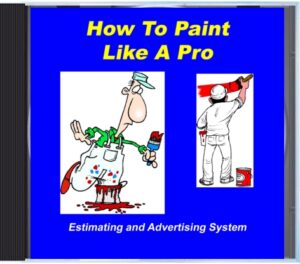 Navigating the world of professional painting requires a blend of artistic skill, business acumen, and marketing savvy.
Navigating the world of professional painting requires a blend of artistic skill, business acumen, and marketing savvy.
This comprehensive guide lays out how to transition from painting as a hobby to a profitable profession. Follow these strategies and tips to turn your passion for painting into a lucrative venture.
I. Building Your Skill Set
1. Education and Training
- Formal Education: Consider pursuing a degree in fine arts or taking courses in painting to improve your skills and knowledge.
- Workshops and Seminars: Attend workshops and seminars to learn new techniques, network with other professionals, and keep up with the latest trends in the industry.
- Online Resources: Utilize online resources, tutorials, and platforms to learn from seasoned painters and improve your craft continuously.
2. Practice
- Consistent Practice: Hone your skills through consistent practice. Develop a daily or weekly routine where you dedicate time to painting.
- Personal Projects: Undertake personal projects to try out new styles and techniques, which could later become your signature style.
II. Creating a Portfolio
3. Showcase Your Best Works
- Quality Over Quantity: Focus on showcasing high-quality works instead of a large number of mediocre paintings.
- Diverse Portfolio: Have a diverse portfolio that showcases different styles and techniques to attract a broader range of clients.
4. Documenting Your Work
- Photography: Invest in good quality photography to document your work. High-resolution images can be used in your portfolio, website, and promotional materials.
- Descriptive Text: Accompany your works with descriptive texts that explain the story, techniques, and inspiration behind each piece.
III. Marketing and Branding
5. Building a Personal Brand
- Unique Selling Proposition (USP): Identify what makes you stand out in the market. It could be your style, technique, or the themes you explore in your paintings.
- Storytelling: Craft a compelling story about your journey and what inspires you to paint. This narrative will help build a personal connection with your audience.
6. Digital Presence
- Website: Create a professional website to showcase your portfolio, blog about your experiences, and list the services you offer.
- Social Media: Leverage social media platforms to build a following, showcase your works, and engage with your audience.
- Email Marketing: Develop an email marketing strategy to keep your audience updated about your latest works, exhibitions, and offers.
IV. Selling Your Art
7. Pricing Your Artwork
- Cost Plus Pricing: Consider the costs involved in creating a painting, including materials, time, and overheads, and add a margin to determine the price.
- Market Research: Conduct market research to understand the pricing strategies adopted by other painters and to set competitive prices.
8. Channels to Sell Your Art
- Online Art Platforms: Utilize online platforms specializing in selling art to reach a wider audience.
- Galleries: Collaborate with galleries to showcase and sell your paintings. It can also provide opportunities to participate in exhibitions and art fairs.
- Direct Sales: Sell your paintings directly through your website or social media platforms, allowing you to retain a higher percentage of the sale price.
V. Networking and Collaborations
9. Networking
- Community Engagement: Engage with the local community by participating in art fairs, community events, and exhibitions.
- Art Associations: Join art associations and groups to network with other artists, learn from their experiences, and collaborate on projects.
10. Collaborations
- Art Collaborations: Collaborate with other artists to create unique works and reach new audiences.
- Corporate Collaborations: Work with corporate clients for commissioned works, which can be a steady source of income.
VI. Managing Your Business
11. Legal and Financial Aspects
- Contracts and Agreements: Draft clear contracts and agreements to outline the terms of your business engagements.
- Taxes and Finances: Manage your finances effectively by maintaining proper records and understanding the tax implications of your business.
12. Customer Service
- Communication: Maintain clear communication with your clients, keeping them informed about the progress of their commissioned works.
- After-Sales Service: Offer excellent after-sales service to build long-term relationships with your clients.
VII. Continuous Improvement
13. Feedback and Reviews
- Client Feedback: Seek feedback from your clients to understand their preferences and areas where you can improve.
- Peer Reviews: Engage in peer reviews to get constructive criticism and to learn from the experiences of other artists.
14. Adaptability
- Market Trends: Stay abreast of market trends and adapt your style and techniques to meet the changing preferences of your audience.
- Technological Adaptations: Embrace new technologies that can help you improve your craft and reach a wider audience.
Conclusion
Embarking on a journey to become a professional painter involves wearing many hats – that of an artist, an entrepreneur, and a marketer. Building a robust skill set, creating a powerful portfolio, understanding the market, and networking with like-minded professionals are essential steps to carve a niche for yourself in the industry.
By focusing on continuous improvement and adapting to the changing market dynamics, you can build a successful and profitable painting business. Remember, the journey to becoming a successful professional painter is a marathon, not a sprint. With patience, perseverance, and the right strategies, you can make money and build a fulfilling career in painting.
Embrace your unique style, and let your art resonate with people. Happy painting!
 Make Money Faster, Easier With This Cool Add-On Painting Business http://AmazingStarMurals.com
Make Money Faster, Easier With This Cool Add-On Painting Business http://AmazingStarMurals.com
Lorem ipsum dolor sit amet, consectetur adipiscing elit. Ut elit tellus, luctus nec ullamcorper mattis, pulvinar dapibus leo.